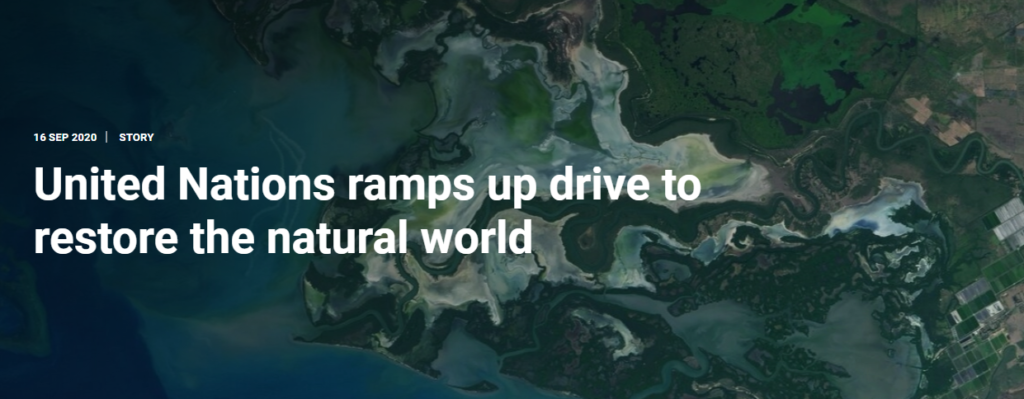
How do you restore a planet? With a shared and inspiring vision, an openness to new ideas and many willing hands.
Alarmed by widespread degradation, the climate crisis and plummeting biodiversity, governments last year declared 2021-2030 as the United Nations Decade on Ecosystem Restoration (UN Decade). During the next 10 years, the initiative is aiming to halt and reverse degradation and raise awareness about the need for restoring the natural world and the many benefits it brings to humankind.
The decade begins next year but work is already underway to build the movement. Starting today, individuals, communities, businesses, governments and others can show their support for reversing the degradation of Earth’s natural systems and creating a more sustainable world.
Individuals and organizations are encouraged to not only use the Decade’s brand-new visual identity, but to make it their own. They can make use of various communication tools in up to eight languages to show that they are part of #GenerationRestoration.
Through a newly launched website, everyone interested in protecting and reviving ecosystems can learn how restoration works and how to get involved in the UN Decade. Groups and organizations can sign up and begin sharing their inspiration, experience and resources.
“The COVID-19 pandemic has laid bare how our health and well-being depend on the health of the planet,” said Inger Andersen, head of the United Nations Environment Programme. “Pulling together in a global movement for restoration is key to making our societies and economies stronger and fitter for the future.”

Every year, the world is losing 4.7 million hectares of forests – an area bigger than Denmark. In the last 100 years, half of the world’s wetlands have been degraded or drained. To achieve the Sustainable Development Goals, prevent catastrophic climate change and save one million species on the verge of extinction, hundreds of millions of hectares need to be revived. This enormous task is too big for anyone organization to undertake. Restoration is a global mission.
A strategy for restoration
A core team has spent months consulting with stakeholders from across the globe on how to achieve the UN Decade’s aims. Having considered more than 2,000 comments from officials, restoration experts, funding partners, indigenous peoples and youth, UNEP and FAO today released a strategy that will underpin the initiative.
A digital platform for the exchange of ideas and technical expertise is being designed for launch in early 2021.
Restoration means reducing human pressures on landscapes and seascapes of all kinds and allowing or helping them to recover, boosting their resilience and productivity.
Initiatives can range from planting a tree or cleaning up a beach – achievable with few resources – to large-scale reforestation or re-wilding schemes with big investments and careful management. Political leaders have a critical role to play in restoration. They can, for instance, change harmful agricultural and fishing policies and channel international finance toward sustainable solutions.
“Reviving ecosystems can bring huge rewards, especially when it is carefully planned and carried out,” said Qu Dongyu, head of the Food and Agriculture Organization of the United Nations. “The UN Decade provides a platform for groups of all kinds to find the information and partners they need to make restoration a success.”

Healthy ecosystems will be essential for achieving the 2030 Agenda for Sustainable Development, including its core drive to eliminate poverty, say experts. Many of the benefits of restoration, from better crop yields and water supplies to protection from natural disasters, would accrue to poor rural communities who depend on forests, fisheries and other natural resources.
Protecting and reviving natural habitats and making farmlands, coasts and cities more sustainable will also help halt dramatic falls in wildlife populations that have left a million species threatened with extinction. And restoring forests and other landscapes that store vast amounts of carbon is a key step on the path toward preventing catastrophic climate change.
Experts are calling on governments and international institutions to seize the opportunity presented by economic recovery plans following the coronavirus pandemic to shift investments toward a so-called “restoration economy” that can provide millions of green jobs.
The UN Decade on Ecosystem Restoration 2021-2030, led by the United Nations Environment Programme, the Food and Agriculture Organization of the United Nations and partners covers terrestrial as well as coastal and marine ecosystems. A global call to action, it will draw together political support, scientific research and financial muscle to massively scale up restoration. Learn more.
For more informationonthe UN Decade on Ecosystem Restoration, please contact Tim Christophersen.TOPICS

